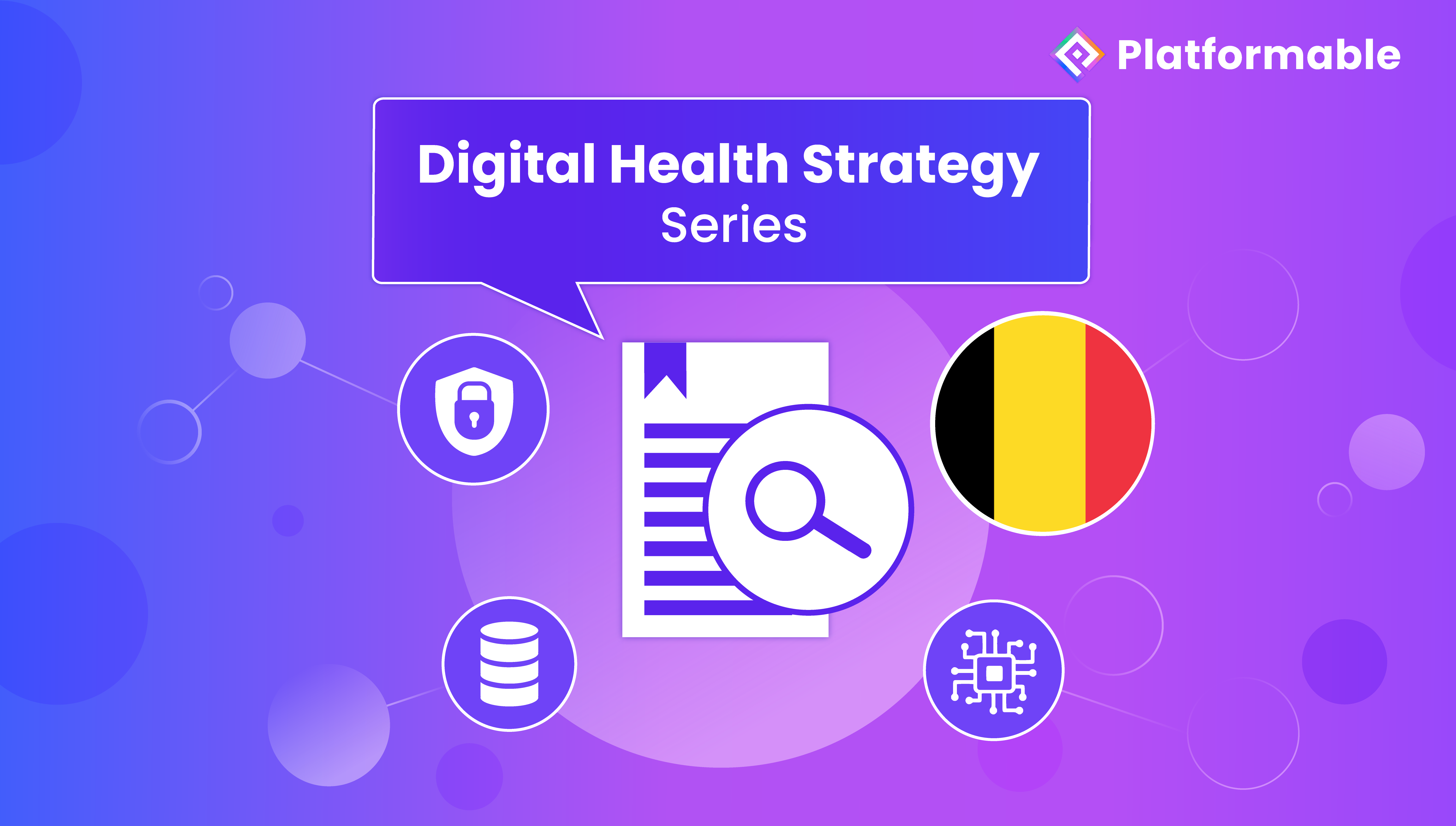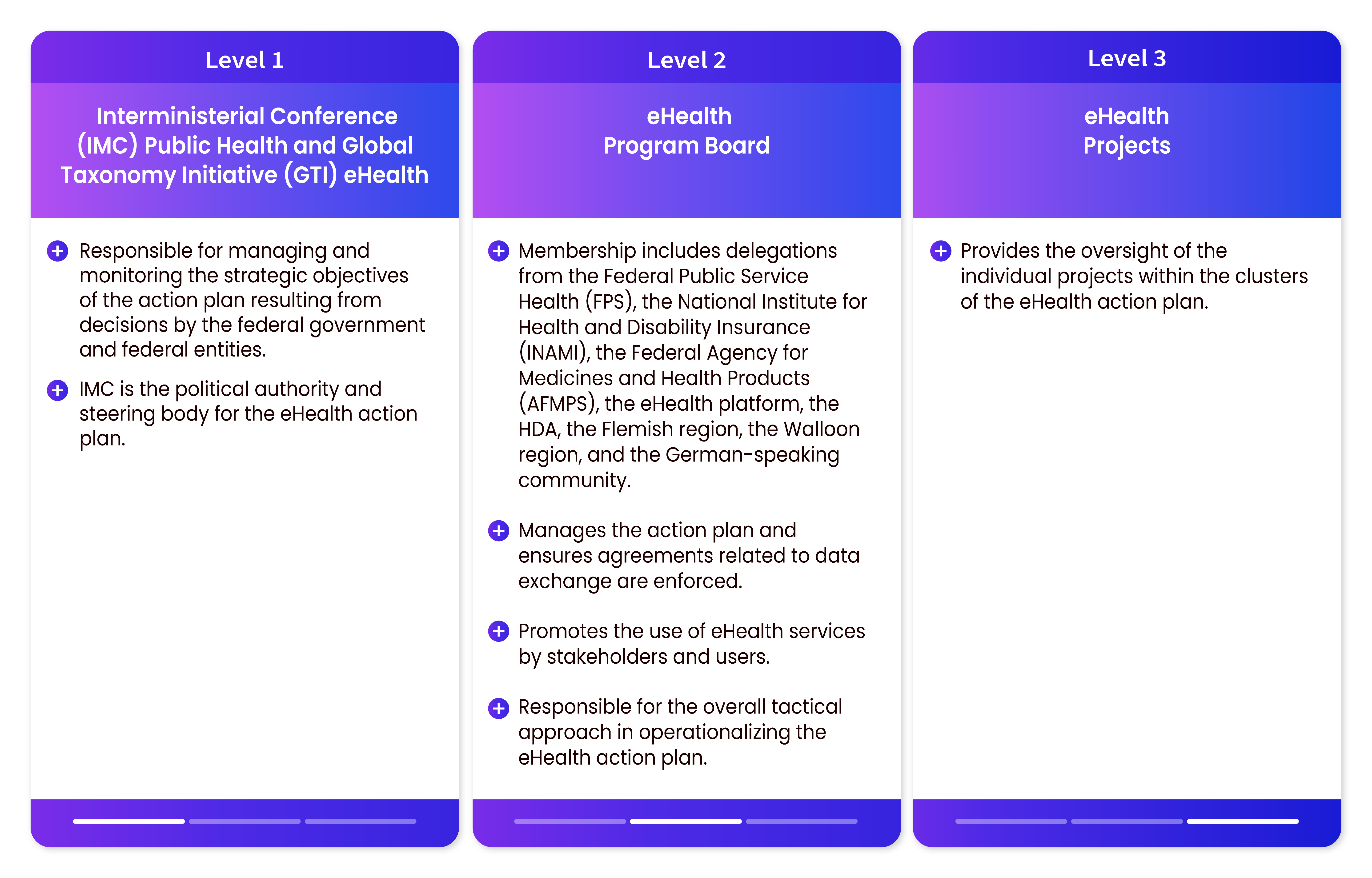Understand
Digital Health Strategy: Belgium

Context
GDP: $USD 583.44 Billion
GDP per capita: $USD 56,080.00
% of GDP spent on healthcare: 11.6
Population: 11.5 million
Life expectancy: 81.7 years
Gini co-efficient: 0.26
UN Human Development Index Score: 0.942
Geopolitical environment: Belgium is a federal constitutional monarchy that consists of a king and prime minister as well as a multi-party system and is a member state of the European Union. The next federal elections will be held on 9 June 2024. As a member of the EU, Belgium is a signatory of the Treaty on the Functioning of the European Union, which describes when national laws should be developed to align with EU-wide legislation, as is the case with the General Data Protection Regulations (GDPR), and is expected in upcoming European Health Data Space legislative initiatives. With one of the highest population densities in Europe, Belgium has an aging population. Still, it is considered a generally healthy population with a life expectancy that continues to rise and a high standard of living. Due to its central location, many public and private organisations have headquarters in Belgium's capital city, Brussels, including the European Union (EU) and the North Atlantic Treaty Organisation (NATO). Belgium is a popular country for investors and attracts billions of euros in direct foreign investments each year.
Overview: Belgium's current digital health strategy
Name: eHealth Action Plan: 2022-2024
Source: Action plan for 2022-2024 implementation
Related documents:
- Protocole d’accord Plan d’actions e-Santé 2019-2021 Protocolakkoord Actieplan e-Gezondheid 2019
- Establishment of Health (care) data agency
Components of the Belgian Digital Health Strategy
Organizational structure
Centralised: Belgium developed its first eHealth action plan in 2013 and is currently on its 4th iteration of the plan which covers 2022-2024. A prominent aspect of the 2022-2024 e-Health action plan is the development of the “Belgian Integrated Health Record” (BHIR), an attempt to create a national centralised framework for the continued development of digital health to support a healthcare system that is integrated and multidisciplinary in its approach.
This framework highlights the importance of the continuity of high-quality care, starting with each citizen and the environment they live in. The six objectives (clusters) outlined for 2022-2024 are:
- Quality, continuity, and safety of care
- Citizen empowerment and access to health data and services
- Empowerment of healthcare professionals and healthcare professionals and access to health data and services
- Facilitate the exchange of data on care and health
- Innovation and promotion of research and development
- Digitization and optimization of administrative processing
Secondary use of health data is also a key element of the eHealth 2022-2024 action plan. The plan provides details on the development of a Belgian Health Data Authority (HDA) that enables stakeholders to access aggregated data for innovation, research, and development, as well as population health management and policy development. (The strategy is silent on whether de-identified and anonymised data at an individual level would be available for secondary use analysis.) The main purpose of the HDA is to make Real World Data available securely by improving the documentation related to the data, increasing its accessibility and retrievability, and ensuring its quality and reusability.
The latest iteration of the action plan recognizes the lessons learned from the previous versions, including changes in the governance structure to decrease the labor-intensive and time-consuming nature of coordination of the various projects developed under the plan.
The governance structure outlined in the eHealth Action Plan provides details on the decision-making process, including the stakeholders involved and the flow of information across different levels to ensure transparency and promote trust. The overall governance structure is divided into three levels:

Use of regulatory levers
The eHealth action plan also acknowledges the current wider European focus on the development of the European Health Data Space (EHDS) regulations with the goal of positioning Belgium to easily meet the regulatory requirements under consideration. In preparing to comply with the regulations, the action plan was developed to incorporate the three pillars of the EHDS as components of the digital health strategy which include:
- An efficient data management system and rules for data exchange
- Data quality
- Good infrastructure and interoperability
The action plan cites multiple laws relating to patients' rights, privacy, health care quality, the EU Data Governance Act, and GDPR as foundational for its success. Additionally, the need to develop legislation for the establishment of the Belgian Health Data Authority as an access point for the EHDS is clearly indicated.
Data governance processes
The BIHR creates a common framework for which the various projects outlined in the eHealth Action Plan focus on achieving interoperability across the system by identifying the relationships that each project has with the BHIR and the HDA. Full interoperability across the system is a key objective of the strategy, which is supported by a multidisciplinary approach to how systems and data are used across the health system. It indicates how data can be used effectively to improve clinical processes and outcomes for primary care but also for innovation and research, development of financing and payment models, and other forms of secondary use of health data.
The BHIR framework mentions the importance of integrating data related to the mental healthcare of patients to create a holistic approach to patient-centric care. Taking into consideration the ongoing efforts for technological innovation in the healthcare space, it highlights the need to think of the integration of medical technologies, through the use of wearables, mobile applications, and other such advancements in the technical, process, and data aspects of the eHealth strategy. It calls out the need to approach the use of these technologies in a fashion that considers how to make them interoperable and standardized in data collection and use while ensuring that security and patient privacy are upheld.
Data infrastructure
The eHealth action plan includes information specific to each project about the hardware and systems that are needed to establish an interoperable digital health data infrastructure. In developing approaches to electronic prescriptions and referrals, the action plan identifies the need to develop a centralised API for data exchange that follows the structure and standards of FHIR. The use of APIs for data exchange and interoperability between various systems and centralized databases for data collection and storage is necessary for several of the projects in the action plan.
The action plan also supports the creation of centralized platforms and support systems to improve the quality of care and make it easier for decision support for clinical testing in the areas of radiology, clinical biology, and antimicrobial agents. Another example is the creation of a provider portal to improve the interaction between providers and for citizens to identify providers based on their specialties and the geographic region in which they are located.
One particular project focuses on the API Economy and Ecosystem and seeks to take an API-first approach to how data is accessed and shared between consumers and data providers. This approach shows the importance of using APIs to enable citizens to access and contribute to their own data collection including the integration of wearable devices.
To support the exchange of data, one of the projects describes the need to create structured data using formats and standards to allow for the automation of data processing and to minimize human intervention in processes. Instituting standardized value sets, coding, and terminology is identified as a necessity to successfully implement the BHIR.
Ecosystem approach
In the development of the eHealth action plan, Belgium has followed an ecosystem approach by engaging individuals and organizations that represent various industries across the healthcare sector in the planning, implementation, and delivery of the projects established in the roadmap. The action plan recognizes the importance of engaging a wide range of stakeholders for its success by taking a participatory approach and includes individuals such as representatives from patient associations, governmental authorities, healthcare professionals and associations, insurance plans, industry professional organizations, academics, research institutions and innovators, and private sector healthcare organizations.
One unique aspect of the action plan is the approach to empowering stakeholders to engage in contributing to the digital healthcare ecosystem and the realization that its success is dependent on the active participation of the citizenry and healthcare providers in interacting with the platforms and tools developed in support of the roadmap. Incorporating principles of transparency and trust, the eHealth action plan brings front and center the importance of creating a system that works for everyone and allows for collaborative engagement to improve the way healthcare is delivered.
Equity
The eHealth action plan discusses the concept of equity in its “5AIM Paradigm of Care and Integrated Care”. As one of the 5 goals of creating a more holistic healthcare system, the digital health strategy acknowledges the importance of increasing equity in society by improving the accessibility of healthcare services in broad terms, particularly indicating that it is not just about financial accessibility. In highlighting the importance of equity, the plan calls out the need to create inclusivity by acknowledging different forms of diversity to establish a true person and people-centered healthcare system. The plan also indicates the importance of an individual’s environment and community and the role it plays in the manner in which a person interacts with the healthcare system.
As a result of the diverse demographics of Belgium, the eHealth action plan includes projects that are dedicated to supporting both the regions of Flanders and Wallonia and take into consideration the particular needs of these populations. The action plan includes specific sections that are dedicated to each of the regions and indicates how the digital health strategy will support regional differences in the healthcare systems with a focus on integration and interoperability across the entire country.
Training/skills-building
In various initiatives and projects outlined, the eHealth action plan details the importance of providing training to stakeholders to develop the skills and understanding for increasing engagement and participation. The “Telecare” project for example acknowledges that its success is dependent on the training of patients, informal caregivers, and providers on the technologies being used to ensure that digital monitoring devices are used appropriately.
In support of the secondary use of health data, the plan includes the creation of a health data academy to share knowledge and provide data users training to support improved data literacy among the population.
Funding and sustainability
While a majority of the funding for Belgium's digital health strategy and infrastructure is provided by federal and regional government budgets, the action plan taps into different funding sources for various projects, including the European Resilience and Recovery Fund and the Belgium Recovery and Transition Plan.
In discussing the 5AIM, one of the goal-oriented approaches for improving the paradigm of care is to increase an emphasis across the healthcare system for moving towards a result-based financing approach, also known as “pay for performance”. Ideally, the BHIR could be used to evaluate financing and payment models for health technology and medicines that follow a “fair pricing” approach and are triggered when certain outcomes are recorded in the BHIR for a patient.
Summary
Belgium has developed a comprehensive digital health strategy that has evolved over the years in its various iterations. The establishment of the BHIR as a central framework for the various projects and initiatives creates a unified strategic plan that puts the citizen/patient at the center, striving to create a truly integrated and multidisciplinary healthcare system. The creation of the Health Data Authority aligns with the EHDS plan and incorporates key principles established to improve the access and quality of health data for secondary use. Throughout the eHealth action plan, Belgium ties its digital strategy to the creation of a demand-driven population-based care system that brings the quality and well-being of its citizens front and center.
Belgium has established clear, well-defined objectives for its digital health strategy and has laid out a roadmap and plan that is achievable and realistic while providing the opportunity for the incorporation of new technologies and methodologies in the future. By focusing on data exchange and interoperability, Belgium's strategy provides a clear pathway on how it will incorporate key principles in the management and use of data and the incorporation of standards that will enable all the stakeholders including citizens to participate in its digital health ecosystem.

Eric Rochman
EXTERNAL PARTNER